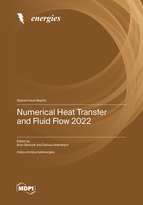Numerical Heat Transfer and Fluid Flow 2022
A special issue of Energies (ISSN 1996-1073). This special issue belongs to the section "J1: Heat and Mass Transfer".
Deadline for manuscript submissions: closed (31 December 2022) | Viewed by 23724
Special Issue Editors
Interests: engineering; non-Newtonian flows; modeling of turbulence in slurry flows; technical sciences; heat transfer
Special Issues, Collections and Topics in MDPI journals
Interests: fluid flow and heat transfer in porous media; fibre suspension flows; Computational Fluid Dynamics (CFD); electrical impedance tomography (EIT)
Special Issue Information
Dear Colleagues,
In the era of digital transformation, which includes converting any processes into a quantified format suitable for future analysis, there is increasing demand on simulations and experiments on heat and fluid flow for a variety of single and multiphase flows and boundary conditions. The importance of heat and fluid flow is still growing in all aspects of our lives, starting from nature and ending with industrial processes. Thanks to computational fluid dynamics and its commercial packages, we can design and perform the optimization of various processes. The increasing ability and understanding of heat and mass transfer phenomena has contributed significantly to effectively managing a variety of processes.
This Special Issue on “Numerical Heat Transfer and Fluid Flow” in the scientific journal Energies is addressed to specialists from all over the world who deal with mathematical modeling and experiments on heat and fluid flow. We welcome papers dealing with solutions of problems of scientific and industrial relevance in the broad fields of heat transfer and fluid transportation, including natural resources, biomedical, industrial processes, etc. Papers addressed to the Special Issue will not only solve specific engineering problems, but will serve as a catalyst on future directions and priorities in numerical heat transfer and fluid flow.
Topics of interest for publication include, but are not limited to, the following:
- Numerical simulations of mass and/or heat transfer;
- Computational fluid dynamics;
- Experiments and simulations of single or multiphase flows, including Newtonian and non-
- Newtonian fluids;
- Modeling, optimization, and control of heat transfer and fluid flow;
- Mini and macro-flows;
- Turbulence;
- Modelling of turbulence;
- Flowing phase interactions;
- Energy saving processes, including increase or decrease in frictional losses and/or heat transfer.
Prof. Dr. Artur Bartosik
Dr. Dariusz Asendrych
Guest Editors
Manuscript Submission Information
Manuscripts should be submitted online at www.mdpi.com by registering and logging in to this website. Once you are registered, click here to go to the submission form. Manuscripts can be submitted until the deadline. All submissions that pass pre-check are peer-reviewed. Accepted papers will be published continuously in the journal (as soon as accepted) and will be listed together on the special issue website. Research articles, review articles as well as short communications are invited. For planned papers, a title and short abstract (about 100 words) can be sent to the Editorial Office for announcement on this website.
Submitted manuscripts should not have been published previously, nor be under consideration for publication elsewhere (except conference proceedings papers). All manuscripts are thoroughly refereed through a single-blind peer-review process. A guide for authors and other relevant information for submission of manuscripts is available on the Instructions for Authors page. Energies is an international peer-reviewed open access semimonthly journal published by MDPI.
Please visit the Instructions for Authors page before submitting a manuscript. The Article Processing Charge (APC) for publication in this open access journal is 2600 CHF (Swiss Francs). Submitted papers should be well formatted and use good English. Authors may use MDPI's English editing service prior to publication or during author revisions.







